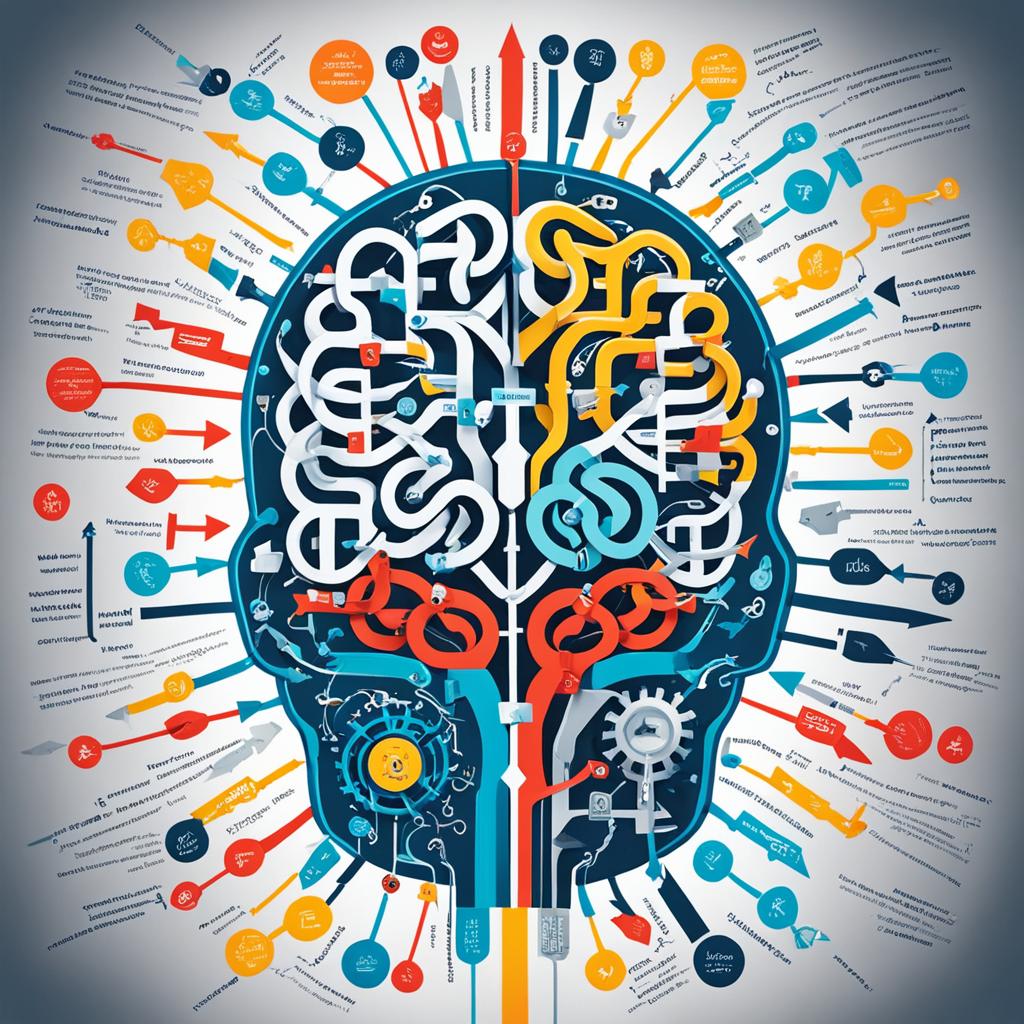Did you know that cognitive biases play a significant role in shaping our judgment and decision making?
These hidden forces act as subtle influencers, guiding our choices in ways we may not even realize. In this article, we will explore the fascinating world of cognitive biases and unravel the impact they have on our decision-making process.
By understanding and recognizing these hidden forces, we can begin to make more informed and objective decisions, free from the constraints of cognitive biases.
Understanding Decision Making
Before we can delve into the fascinating world of cognitive biases, it is crucial to have a solid understanding of the decision making process. Decision making is a complex mental process that we engage in daily, whether consciously or unconsciously. It involves assessing options, evaluating potential risks and benefits, and ultimately making a choice.
When it comes to decision making, our cognitive biases play a significant role. These biases are subconscious patterns of thinking that can distort our judgment and influence our choices. By understanding how decisions are made and the various factors that come into play, we can gain valuable insights into the workings of our own minds.
There are several models and theories that attempt to explain the decision making process. One well-known model is the rational decision making model, which suggests that individuals make decisions by reviewing all available information, weighing the pros and cons, and selecting the option that maximizes their utility.
However, research has shown that decision making is not always a rational and logical process. Our cognitive biases can lead us astray, causing us to make decisions based on faulty reasoning or incomplete information. These biases are often deeply ingrained and can be difficult to recognize and overcome.
By exploring the intricacies of decision making and the role of cognitive biases, we can gain valuable insights into our own thinking patterns and improve our ability to make more informed decisions. In the next section, we will delve into the world of cognitive biases and explore the different types that influence our judgment and decision making.


Introduction to Cognitive Biases
In the realm of decision making, cognitive biases play a fascinating and significant role. These biases are systematic patterns of deviation from rationality that have a profound impact on our judgment and choices. Understanding the various types of cognitive biases can shed light on why we make certain decisions and help us become more aware of the hidden forces at play.


Confirmation bias, anchoring bias, availability heuristic, and overconfidence bias are just a few examples of cognitive biases that impact our decision making process. Each bias has its own unique effect, distorting our perceptions and leading us to make choices that may deviate from rationality.
By being aware of these cognitive biases, we can recognize when they are at play and take steps to mitigate their influence. When we understand the underlying mechanisms of these biases, we become better equipped to make more informed and objective decisions.
Confirmation Bias: The Power of Seeking Validation
Confirmation bias is a common cognitive bias that profoundly influences decision making. It occurs when individuals actively seek out information that confirms their existing beliefs while disregarding or dismissing contradictory evidence. This bias can have significant implications and distort the way we perceive reality.
“Confirmation bias is one of the most prevalent and impactful cognitive biases that affect our decision making,” says Dr. Rachel Martinez, a cognitive psychology expert.
This bias can arise from various factors, including our desire for validation and the discomfort we experience when faced with opposing viewpoints. It can lead us to ignore critical and diverse perspectives, limit our access to a wide range of information, and ultimately hinder our ability to make well-rounded and informed choices.
The consequences of confirmation bias can be far-reaching, influencing multiple aspects of our lives, from personal relationships to professional decisions. It can result in the perpetuation of stereotypes, the reinforcement of harmful beliefs, and the polarization of opinions.
Confirmation bias also contributes to the echo chamber effect, where individuals surround themselves with like-minded people and sources of information that affirm their existing views.
Overcoming confirmation bias requires a conscious effort to challenge our own beliefs, actively seek out opposing viewpoints, and evaluate evidence objectively. By broadening our perspectives and considering diverse opinions, we can navigate cognitive biases and make more informed and unbiased decisions.
Confirmation Bias in Action: A Case Study
To illustrate the impact of confirmation bias, let’s consider a case study in the context of investing. John, an experienced investor, holds a strong belief that a particular technology company’s stock is bound to soar. Amidst this belief, John actively searches for positive news articles, analyst reports, and investor forums that align with his view.
He conveniently avoids and dismisses any conflicting information that questions the company’s prospects or raises concerns. As a result, John fails to consider valuable insights and warning signs that may impact his investment decision.


The image above visually represents the pull of confirmation bias, symbolizing how our preconceived beliefs can overshadow opposing information and limit our perspectives.
“Confirmation bias can blind us to essential data and prevent us from making well-informed decisions,” warns financial advisor Sarah Thompson.
By acknowledging and consciously addressing confirmation bias, individuals like John can develop a more balanced and unbiased approach to decision making, enabling them to analyze information from a broader and more objective standpoint.
Anchoring Bias: The Influence of Initial Information
Anchoring bias is a cognitive bias that can have a significant impact on our decision-making process. It occurs when individuals place disproportionate weight on the first piece of information they encounter, using it as a reference point for making judgments.
Imagine you are shopping for a new laptop. As you browse through different options, you come across a high-end model with a hefty price tag. This initial price becomes an anchor, influencing your perception of value for other laptops you encounter. Even if a similar laptop is objectively priced lower, your judgment may be biased by the anchoring effect of the initial high price.
Anchoring bias can lead us to make irrational decisions, as we become fixated on the initial information presented to us. This bias is often used strategically by marketers and salespeople to influence consumer behavior. By setting a high anchor price, subsequent offers can appear more attractive, even if they are still relatively expensive.
“Anchoring bias is like a mental magnet that pulls our judgments towards the initial information we receive.”
Overcoming anchoring bias requires conscious effort and awareness of its influence. By actively questioning the validity of the initial information and seeking additional perspectives, we can mitigate the impact of anchoring on our decision making.
In the next section, we will explore another cognitive bias, the availability heuristic, and its role in shaping our choices based on recent experiences.


Availability Heuristic: The Power of Recent Experiences
The availability heuristic is a cognitive bias where individuals rely on readily available information to make decisions. It involves giving more weight to recent experiences or information that comes to mind easily.
This bias is driven by the idea that if something is easily recalled or accessible in memory, it must be more important or relevant. The availability heuristic can lead to biases in judgment and decision making, as it influences our perception of the frequency or likelihood of events based on what we remember or can easily retrieve.
For example, imagine you are considering visiting a new city for your next vacation. You recently watched a documentary showcasing the city’s vibrant nightlife and tourist attractions. Because these recent experiences are readily available in your memory, you may perceive the city as a popular and exciting destination, leading you to make a biased decision.
“The availability heuristic can be a useful mental shortcut, allowing us to quickly assess situations and make decisions. However, it can also lead to cognitive biases and distort our judgment if we rely too heavily on recent experiences.”
Being aware of the availability heuristic and its impact on decision making can help us make more objective and informed choices. By actively seeking out diverse information and considering a wider range of experiences, we can mitigate the potential biases caused by this cognitive bias.
The image above visually represents the concept of the availability heuristic and its influence on decision making. It serves as a reminder of how easily accessible information can shape our perceptions and choices.
Overconfidence Bias: The Perils of Overestimating Abilities
Overconfidence bias is a cognitive bias that can significantly impact our decision making. It occurs when individuals have an inflated belief in their own abilities and the accuracy of their judgments. They tend to overestimate their skills and underestimate the risks involved, leading to flawed decision making.
This cognitive bias can manifest in various situations, both in personal and professional contexts. For example, someone with overconfidence bias may confidently embark on a challenging project without considering the potential obstacles and pitfalls. They may underestimate the time, effort, and resources required, leading to project failures and missed deadlines.
Overconfidence bias can also affect financial decision making. Investors may overestimate their ability to predict market trends and make risky investments based on their unwarranted confidence. This can result in significant financial losses.
Cognitive biases like overconfidence bias can hinder our ability to make rational and informed decisions. It clouds our judgment, making us blind to potential risks and limitations. By understanding and recognizing the existence of this bias, we can take steps to mitigate its negative effects.
One way to counter overconfidence bias is through self-reflection and seeking external feedback. Engaging in critical self-assessment and soliciting input from others can provide valuable insights and help temper our overestimation of abilities.
Another strategy is to encourage a diversity of perspectives within a decision-making process. By creating an environment where multiple viewpoints are considered and debated, we can challenge our own assumptions and reduce the influence of overconfidence bias.
“Overconfidence bias is like driving with blinders on; it narrows our vision and prevents us from seeing the full picture.”
By acknowledging and addressing overconfidence bias, we can enhance our decision making by incorporating more accurate assessments of our abilities and considering a broader range of possibilities. It is essential to foster a culture that values self-awareness, humility, and critical thinking to mitigate the perils of overconfidence bias.


Next, we will explore another influential cognitive bias known as the framing effect and how presentation shapes our choices.
Framing Effect: How Presentation Influences Choices
The framing effect is a powerful cognitive bias that highlights the profound impact of information presentation on our decision-making process. The way information is framed, whether positively or negatively, can significantly influence the choices we make. This section will delve into the implications of the framing effect and explore how it can sway our decision-making process.
When it comes to decision making, how information is presented can shape our perceptions, preferences, and ultimately, our choices. The framing effect occurs when the same information is presented in different ways, leading to varying decision outcomes.
For example, imagine you’re considering a new smartphone purchase. If the product is framed as having “90% customer satisfaction,” the positive frame may make you more inclined to view it favorably and proceed with the purchase. On the other hand, if the same product is framed as having “10% customer dissatisfaction,” the negative frame might make you hesitant and reluctant to buy.
This bias demonstrates the importance of carefully considering how information is presented to others, as well as being aware of how information is being framed when making decisions ourselves. Marketers, advertisers, and politicians often leverage the framing effect to influence consumer behavior and shape public opinion.
Understanding the framing effect allows us to recognize when our judgment is influenced by the presentation of information. By being aware of this bias, we can critically evaluate and challenge the framing of information to make more objective and informed decisions.
The framing effect is just one of many cognitive biases that impact our decision making. Throughout this article, we have explored various cognitive biases that shed light on the hidden forces behind our judgments and choices. By understanding these biases, we can navigate decision making more effectively and mitigate their influence.
Conclusion
In conclusion, understanding the hidden forces behind decision making is essential for making informed choices. Cognitive biases, which are systematic patterns of deviation from rationality, significantly impact our judgment and decision making. By recognizing and mitigating the influence of these biases, we can approach decision making with more clarity and objectivity.
Throughout this article, we explored various cognitive biases that shape our thinking and choices. Confirmation bias, for example, leads us to seek out information that confirms our existing beliefs, while anchoring bias influences us to rely heavily on initial information. The availability heuristic and overconfidence bias also impact our decision making, often leading to suboptimal outcomes.
Furthermore, the framing effect demonstrates how the presentation of information can sway our choices. By understanding these cognitive biases and their implications, we can become more aware of the potential pitfalls in our decision making process. With this awareness, we can take steps to minimize the impact of biases and approach our decisions with a more rational and objective mindset.
